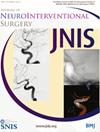应激性高血糖对大面积缺血性脑卒中患者预后的影响
IF 4.5
1区 医学
Q1 NEUROIMAGING
引用次数: 0
摘要
背景 关于应激性高血糖比值(SHR)对是否接受血管内治疗的大面积缺血性卒中患者的潜在影响的临床证据尚不明确。方法 本研究是一项前瞻性多中心登记的子分析,纳入了中国 38 个中心的 745 例大面积缺血性卒中患者。共纳入 427 例患者,其中 285 例接受了血管内治疗(EVT),142 例接受了标准药物治疗(SMT)。SHR定义为血糖(mmol/L)/(1.59 × HbA1C)-2.59。主要结果是 90 天后的中度神经功能结果(改良 Rankin 量表 (mRS) 评分≤3)。结果 观察到SHR与是否接受EVT之间存在明显的交互作用(P=0.017)。在接受EVT的患者中(调整OR (aOR) 0.46; 95% CI 0.23 to 0.92; p=0.029),SHR最高三分位数的患者与最低三分位数的患者相比,在90天后获得中度神经功能预后的可能性明显较低。然而,在接受 SMT 的患者中并未观察到这种关联(aOR 2.46;95% CI 0.74 至 8.21;p=0.142)。与 SHR 较低的 EVT 患者相比,SHR 较高的 EVT 患者发生症状性颅内出血的几率明显更高(aOR 3.29;95% CI 1.08 至 10.06;p=0.036),而在 SMT 组中未观察到这种关联(aOR 1.52;95% CI 0.56 至 4.12;p=0.410)。结论 在接受 EVT 治疗的大面积缺血性卒中患者中,SHR 与获得中度神经功能预后的可能性降低以及症状性颅内出血的风险增加有关。试验注册号:ChiCTR2100051664。如有合理要求,可提供相关数据。支持本研究结果的数据可向通讯作者索取。本文章由计算机程序翻译,如有差异,请以英文原文为准。
Impact of stress hyperglycemia on outcomes in patients with large ischemic stroke
Background Clinical evidence of the potential influence of stress hyperglycemia ratio (SHR) for patients with large ischemic stroke whether or not receiving endovascular therapy is not clear. Methods This study was a subanalysis of a prospective, multicenter registry, and included 745 patients with large ischemic stroke across 38 centers in China. A total of 427 patients were included in this study, with 285 received endovascular therapy (EVT) and 142 received standard medical therapy (SMT). SHR was defined as glucose (mmol/L)/(1.59 × HbA1C)–2.59. The primary outcome was a moderate neurological outcome (modified Rankin Scale (mRS) score ≤3) at 90 days. Results A significant interaction was observed between SHR and whether received EVT (p=0.017). Among patients who received EVT (adjusted OR (aOR) 0.46; 95% CI 0.23 to 0.92; p=0.029), patients in the highest tertile of SHR were significantly less likely to achieve a moderate neurological outcome at 90 days compared with those in the lowest tertile. However, this association was not observed in patients receiving SMT (aOR 2.46; 95% CI 0.74 to 8.21; p=0.142). EVT patients with higher SHR had a significantly higher incidence of symptomatic intracranial hemorrhage compared with lower SHR (aOR 3.29; 95% CI 1.08 to 10.06; p=0.036), while such an association was not observed in the SMT group (aOR 1.52; 95% CI 0.56 to 4.12; p=0.410). Conclusions In patients with large ischemic stroke treated with EVT, SHR is associated with a reduced likelihood of achieving a moderate neurological outcome, as well as an increased risk of symptomatic intracranial hemorrhage. Trial registration number ChiCTR2100051664. Data are available upon reasonable request. The data that support the findings of this study are available from the corresponding author upon reasonable request.
求助全文
通过发布文献求助,成功后即可免费获取论文全文。
去求助
来源期刊

Journal of NeuroInterventional Surgery
NEUROIMAGING-SURGERY
CiteScore
9.50
自引率
14.60%
发文量
291
审稿时长
4-8 weeks
期刊介绍:
The Journal of NeuroInterventional Surgery (JNIS) is a leading peer review journal for scientific research and literature pertaining to the field of neurointerventional surgery. The journal launch follows growing professional interest in neurointerventional techniques for the treatment of a range of neurological and vascular problems including stroke, aneurysms, brain tumors, and spinal compression.The journal is owned by SNIS and is also the official journal of the Interventional Chapter of the Australian and New Zealand Society of Neuroradiology (ANZSNR), the Canadian Interventional Neuro Group, the Hong Kong Neurological Society (HKNS) and the Neuroradiological Society of Taiwan.
 求助内容:
求助内容: 应助结果提醒方式:
应助结果提醒方式:


